The Samsung Galaxy S7 and S7 edge Review: Part 2
by Joshua Ho on July 5, 2016 8:00 AM EST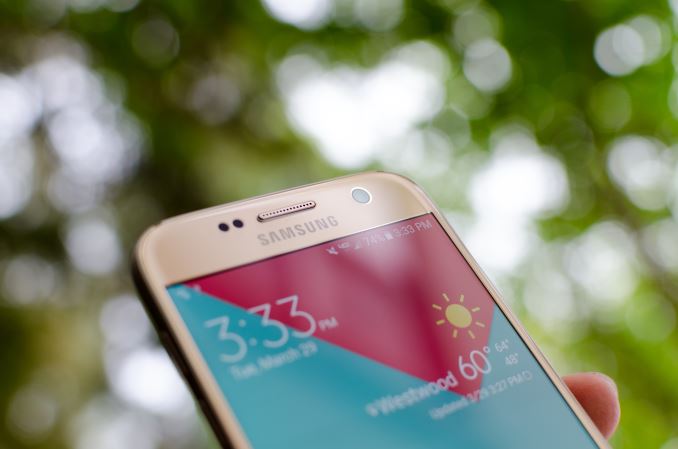
With part one of our Galaxy S7 review, it was clear that the Galaxy S7 was at least a mild improvement to the Galaxy S6 in some ways, but there were still many areas to investigate. At the time, we were in the middle of transitioning to our new 2016 benchmark suite, which meant that it was necessary to re-test the Galaxy S7.
Our 2016 benchmark suite attempts to really push our testing in general to a new level of depth and more importantly, more focused on the overall user experience. When reflecting upon the value of AnandTech from a testing perspective, it’s clear to me that while part of our value is running benchmarks across a wide range of phones, another part of our value is being able to run tests that others wouldn’t be able to run at all.
With our new test suite for 2016, our extended suite of benchmarks attempts to focus on the latter to go deeper in reviews in a meaningful way. I definitely enjoy examining architectural details through microbenchmarks, but for general reviews our standard test workflow needed to be focused on user experience in a deeper way. With this in mind, we can get into the data that we were missing with part 1 of the review. Of course, if you haven’t read part 1 of the Galaxy S7 review, I highly recommend reading it first just to get a better introduction into the basics of the Galaxy S7.
Battery Life
Of course, now that we have our full suite of benchmarks we can start to look over in detail how devices perform. While we’ve gone over some of the results before it’s probably fair to say that our discussion of battery life on the Galaxy S7 was woefully incomplete with part 1 of the review. It’s also worth noting that internally we were still working on our 2016 web browsing test at the time so it wasn’t necessarily complete and sufficiently consistent and accurate. In the time since, we’ve been able to get all of the bugs ironed out and get a test that provides useful data that our previous tests didn’t.
As battery life is a critical part of our testing, it’s important for us to get this right, and in order to get useful relative comparisons we have to make sure that every device is tested in the same manner to avoid bias in one way or another. In order to achieve this, all devices have all possible background services disabled, as well as sync and automatic app updates. In order to try and make an even comparison we also set the display to 200 nits brightness on a 100% average picture level display, also known as a blank white screen. However, one area that we aren’t necessarily able to control for 100% of the time is ambient temperature, device orientation, or material contact. While tests that don’t reach TDP limits won’t see any effects, TDP-limited tests will see a delta here, but it’s hard to estimate just how much of an impact exists here.
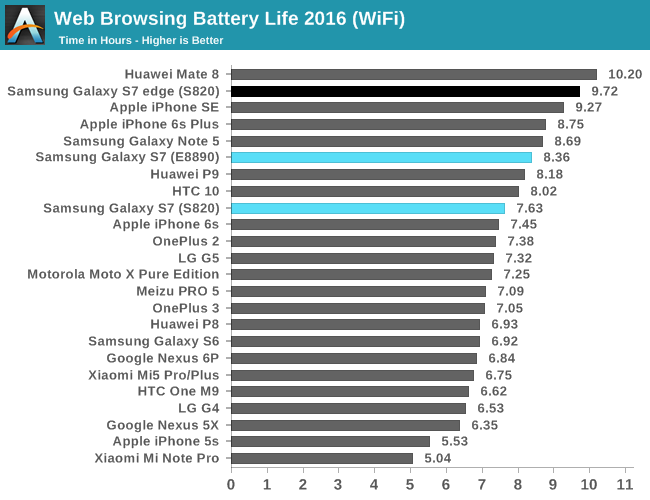
With this baseline in mind we can move on to the actual results. As seen in the chart above for WiFi web browsing on our new test it’s worth mentioning that the data here has changed as changes to the test have affected results, generally bringing battery life down or keeping it around the same. The Galaxy S7 does fairly respectably here, although the Snapdragon 820 version is definitely showing either architectural or implementation inefficiency here when compared to the Exynos 8890. A delta of about 10% means that the Exynos 8890 GS7 uses about 1.38W average here while the Snapdragon 820 GS7 uses about 1.51W in this test assuming that the battery capacity is nominal. If you subtract out an estimated display power the delta that can be attributed to non-display factors is something like 30% here. Interestingly, the HTC 10 is mildly more efficient here with its higher density LCD, with the AMOLED display consuming something like 10% more power despite the presence of dark-themed webpages to try and bring some balance here. The Galaxy S7 edge is pretty much the top here, but achieves its battery life through sheer battery size rather than efficiency.
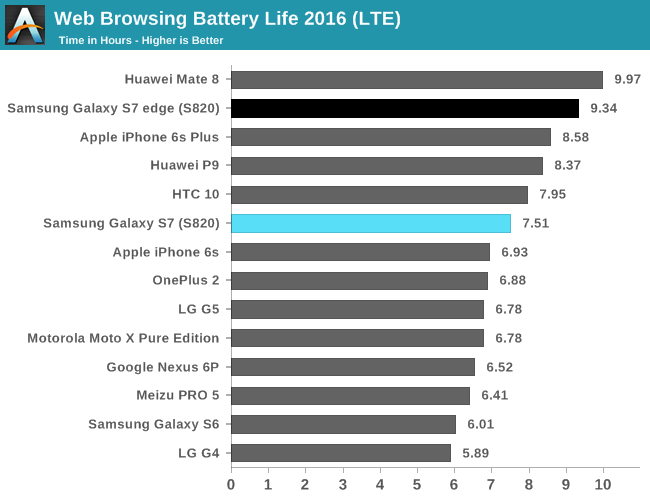
Moving on to LTE we can really start to see the battery life advantage that the Snapdragon 820 brings. It turns out that as a communications company, Qualcomm is good at making radios. One of the most obvious ways that this shows is in power, as the Snapdragon 820 basically has the same battery life whether you’re on LTE or WiFi, which isn’t necessarily the case with other devices. Unfortunately, we haven’t been able to test the Galaxy S7 with Exynos 8890 in comparable conditions for LTE so we can’t really see how power of the S820 modem compares with the Exynos’ Shannon modem, but we continue to see that the Galaxy S7 S820 is a bit behind the HTC 10 in battery life due to the use of an AMOLED display in high-APL workloads. However, the difference is nowhere near what it was in the past, and is close enough to not really make a huge difference. The Galaxy S7 edge performs well here, but on the basis of its battery size rather than efficiency.
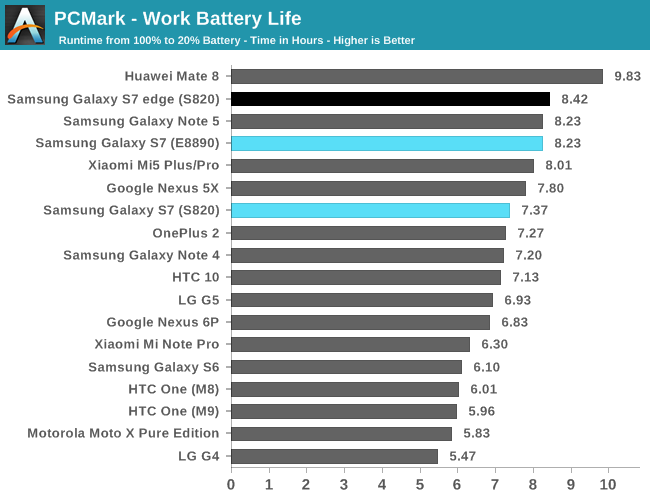
In the interest of not just relying on our own web browsing tests to try and get a handle for what battery life is like in general purpose compute situations, we continue to use PCMark’s battery life test to see how performance is in a benchmark that doesn’t attempt to equalize the amount of work done per unit time. Here the Galaxy S7 actually seems to be a fair bit better than the HTC 10, but this is likely due to the previously mentioned binning differences and some differences in governor as the delta in power and performance isn’t really all that much. The Galaxy S7 edge extends the lead here, again mostly due to the larger battery as the two devices are generally quite similar to each other.
Moving on to throttling performance we’ve transitioned to GFXBench’s Manhattan test on infinite rundown instead of T-Rex for this year as some devices from certain vendors have a tendency of reaching vsync on T-Rex which meant that it was difficult to see just how much throttling occurred over the duration of the test. After some testing it’s evident that for the most part throttling behavior is not necessarily changed by Manhattan either, so there’s not much need to retain T-Rex for high-TDP tests. Basemark OS II’s battery life testing is also rather questionable at this point, so we will no longer be reporting these scores as the methodology isn’t up to par with our expectations for 2016 and beyond.
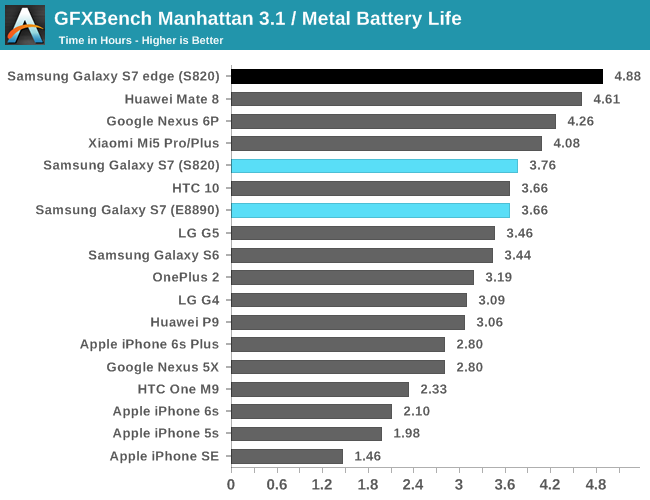

In the case of Manhattan, we continue to see some of the sinusoidal behavior seen in T-Rex throttling as it seems that Samsung’s throttling algorithms tend towards a more underdamped behavior than critically damped like HTC’s. However, for whatever reason it looks like the Galaxy S7 edge ends up with similar oscillating throttling behavior. Interestingly enough, even though the Galaxy S7 spends more time at higher performance states than the HTC 10, it manages to last longer, which is likely due to the lower APL of this content in conjunction with forced power save modes, and higher sustainable skin temperatures due to the glass back with heatpipe cooling to help distribute heat. Of course, the Galaxy S7 edge manages to last longer than either due to its larger size and battery.
Overall, the Galaxy S7 has decent battery life, while the S7 edge has great battery life due to its relatively large battery compared to its display size. The improvements here aren’t necessarily going to blow you away unless you get the Exynos 8890 variant, but it’s good to see that we’re finally back to improving on battery life with the launch of the Snapdragon 820 compared to the Snapdragon 810 and 808’s rather disappointing power efficiency due to the use of a high-power implementation and process node. I’m not sure the Snapdragon 820 is really the best design we’ve seen on 14LPP when it's more on par with 14LPE SoCs for efficiency, but it’s good enough that it doesn’t fundamentally compromise a device.


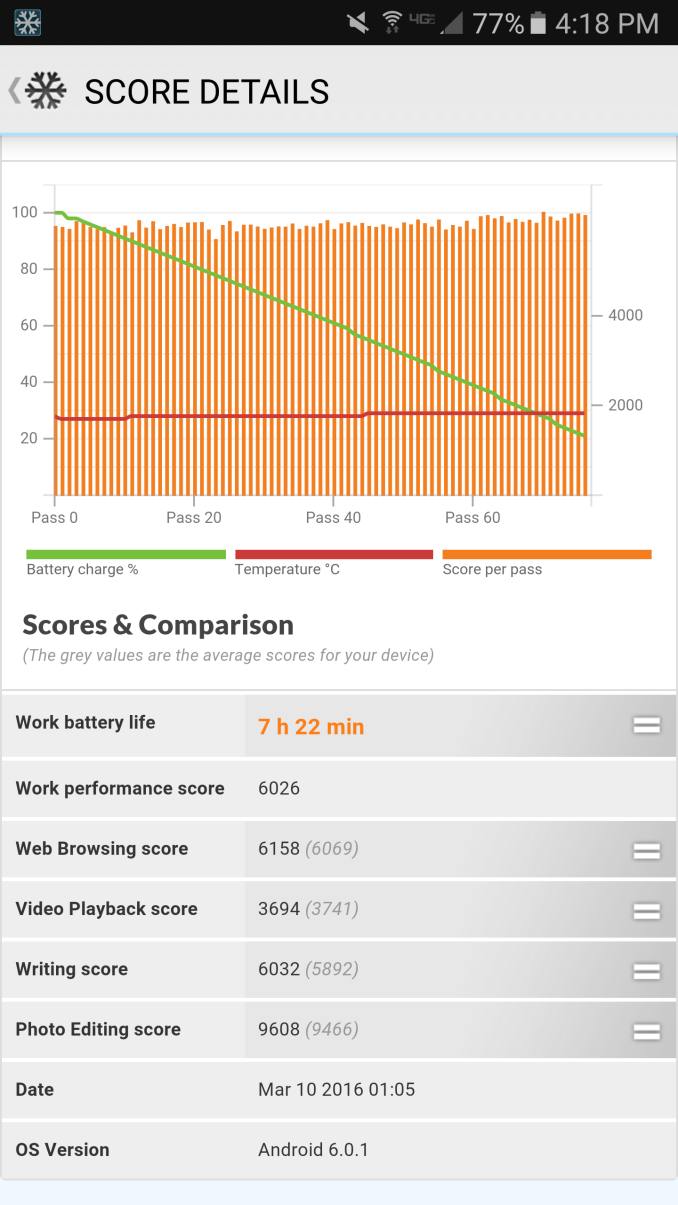
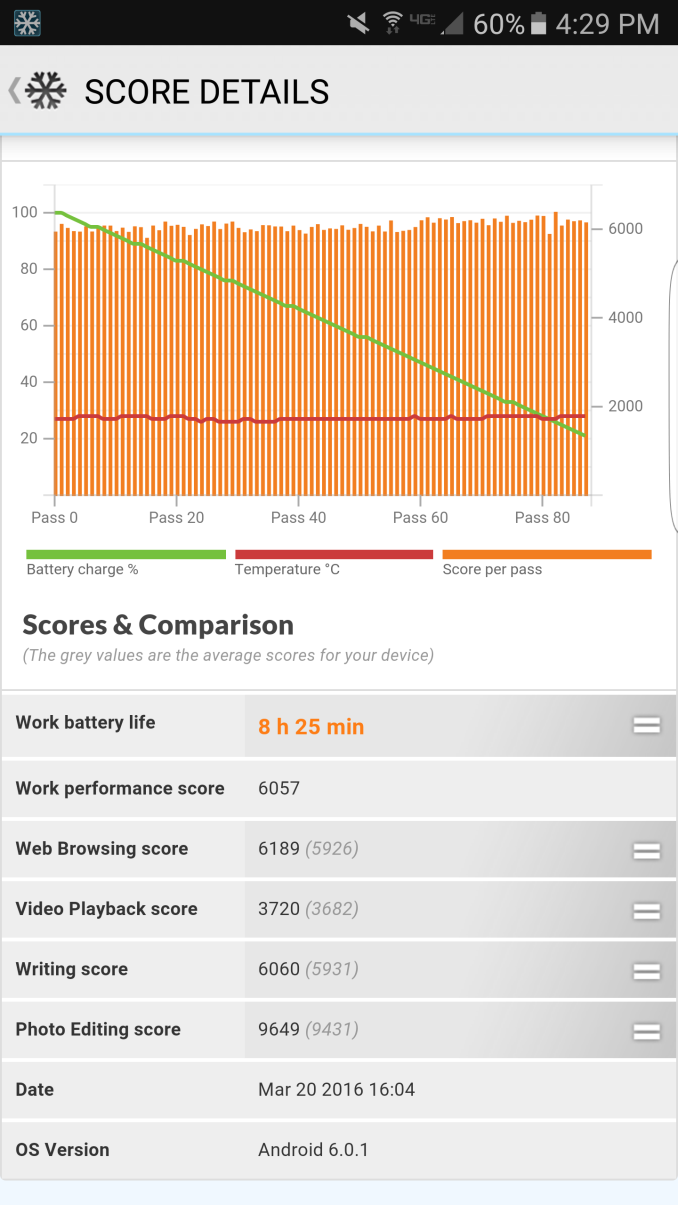
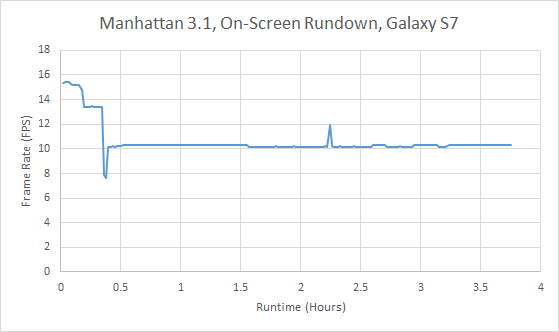
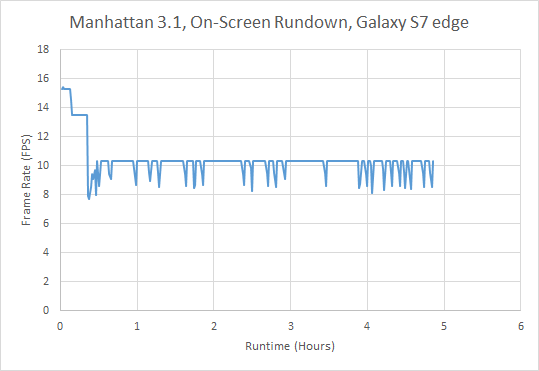








266 Comments
View All Comments
realbabilu - Thursday, July 7, 2016 - link
If we bought for performance. The lags or the speed of apps is quite small than last one or two years ago oneplus one s801, you can't fell it big difference unless on benchmarking apps.The photos can tell different story, you can know it good or bad than last year mobile or other features like ois
ntp - Thursday, July 7, 2016 - link
That's a very thoughtful reply, Impulses, thanks. But with the small sensors of smartphones I think 3/4ths of a stop is a significant advantage, more so than in the case of large sensor cameras, since we'd care about the F number in low light scenarios, where the ISO will be high. I'm just saying it should be better emphasized so people understand the real world advantages it gives.Impulses - Thursday, July 7, 2016 - link
It's a valid point, I'm just saying you can't look at that in a vacuum, specially since you're not looking at an ILC anyway... If you can't swap any parts, then the end result is all that really matters and that includes sensor efficiency, post processing (unless you're shooting RAW, a rarity on phone users), the presence of OIS, effectiveness of the latter, and even things like how smart the auto mode is...That last bit is probably beyond AT's more data driven evaluation, but a phone that relies to heavily on OIS for instance (or HDR) might take more blurry shots under real life conditions... That actually does favor a faster aperture but the point is emphasising specs in a vacuum is pointless.
mavsaurabh - Tuesday, July 12, 2016 - link
I just wish to reply regarding aperture , you rightly said that f no causes cost to skyrocket in case of lslr ens all else being equal, the catchphrase is all being equal ! In case of constraints of mobile photography, lens stack size & weight limitations, heat produced etc leads to various compromises like plastic lens which coupled with bigger apertures leads to higher corner aberration, diffraction etc etc. in end as Impulses wrote what matters is the end result which is fine tuned balance of various compromises made !I am a pixel peeper and street, landscape photgrapher by hobby with 25 years of film and digital shooting through Slr's , mobiles , compacts, Fuji X100.
My observation is that samsung uses hard sharpening and over saturated colors which "creates" pleasing photos on phone screen but if you display it on decent monitor and zoom to even 50% you will see various artefacts and no latitude for post processing. Now most of casual photographers will like larger than life portrayal or smearing of face pimples etc by clever use of face detection but hey any one who loves photography will differ!
I completely agree about fast focussing advantages but honestly i am yet to use a mobile camera with lens fast enough to freeze pet/ child movement in indoor light to take advantags of fast focussing.
Only phone which was able to do that with use of proper flash though is Nokia 808 Pureview and kudos to its mazing manual controls plus superb post processing which bettered apple even in natural post processing !
beggerking@yahoo.com - Wednesday, July 6, 2016 - link
please just stop those BS apple biased benchmarks at 10x lower resolution... just take them off the chart! its not even a good comparision and serves no uses.realbabilu - Thursday, July 7, 2016 - link
What you see on your screen mobile is what you get. Offscreen just measuring the gpu can do,basically it useless for user because you can't see it.lilmoe - Wednesday, July 6, 2016 - link
"The one notable shortfall here is that Samsung only allows 800 ISO max in manual ISO mode when the true maximum is 1250"I had that number in mind when I read it last night, and was too lazy to test. I've tested it now and my unit can go up to 1600 ISO. Is that also a variable difference in Samsung's sensor (mine is Samsung made), or is the extra third stop on mine extended?
Chris_m1296 - Wednesday, July 6, 2016 - link
Joshua ho, how did the exynos 8890 manage this score on slingshot es 3.1 unlimited? mine only got 2223 and even 3dmark themselves list the exynos version at 2223.UtilityMax - Wednesday, July 6, 2016 - link
Some people complain that the review is too harsh. But my personal view is that if this is a +650USD smartphone that _also_ happens to be carrier locked, it'd better be not just good, but _excellent_ in every respect. Otherwise, it's not clear what exactly justifies the price premium over a phone like Oneplus 3 or why a typical shopper should choose this over an apple product.Impulses - Thursday, July 7, 2016 - link
I kinda agree... I still feel some areas could've been better tested given how long the review date got dragged out, but there was still content here that's pretty unique to AT. I think the market, overall, is definitely giving the high end OEM too much of a pass given the prices phones are now commanding.A $1,000+ laptop with performance sapping bloat that the user can't remove (that aren't part of the core OS) would get ripped to shreds. It's time $700+ phones were held to the same standards.